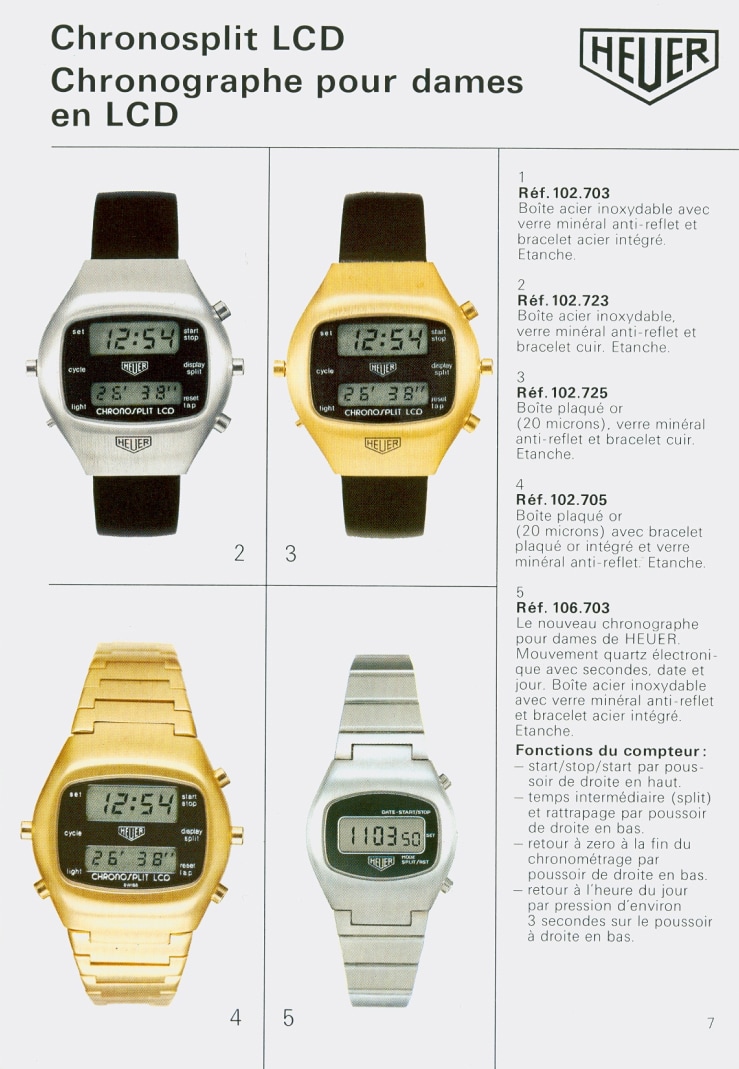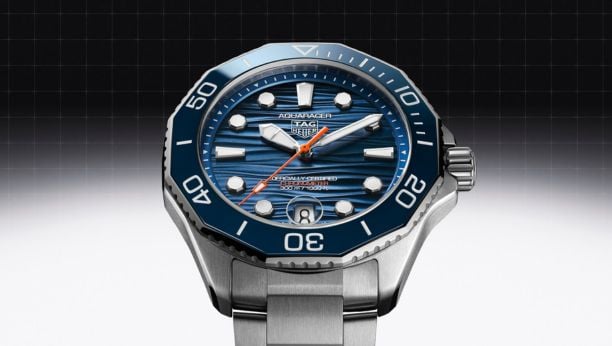VINTAGE COLLECTION
HEUER DIGITAL WATCHES
Heuer was in a unique position when the Swiss watch manufacturers began to produce quartz-powered watches and chronographs with digital displays or mixed analog-digital displays. The first digital watches were styled to make a clean break with the past and contained highly advanced technology, with the watches selling at a premium over their mechanical counterparts. By the time we get to the early 1980s, a “digital” Heuer watch was simply a conventional analogue model with a narrow window showing additional functionality. The revolution progressed quickly, and what was rare and groundbreaking in the mid-1970s had become common by the end of the decade.
It was the pace of development in microchips that was to blame, as digital LCD technology quickly became cheap and ubiquitous: the high-end models from Heuer and other Swiss manufacturers offered little advantage over the mass-produced models from Japan. Digital was no longer advanced, or high-tech…it was simply inexpensive, which is not something Heuer or the other Swiss watch brands wanted to be.
Forty five years later, the Chronosplit, Manhattan and Senator have a strong following among collectors, marking the moment when Heuer and the Swiss brands embarked on a new journey into the digital realm.

Collectors often reflect on the 1970s as being the most dynamic decade in Heuer’s history, a case that’s easy to make when you look at the combination of the ground-breaking Chronomatic (Calibre 11 and 12) movement and a roll-call of famous names: Monaco, Silverstone, Monza and Montreal, and automatic versions of the Autavia and Carrera, to name but a few. The other reason that the 1970s stands out is that at the same time as Heuer was developing innovative mechanical chronographs, it was also at the forefront of high-precision digital quartz technology.
The interest in electronics was very much driven by Jack Heuer, who would go on to have a long career in the electronics industry after leaving Heuer in 1982. Jack visited Silicon Valley in 1972 and saw first-hand the advances in Microchip technology. While Heuer launched the Microsplit 800 (the world’s first digital stopwatch) in 1972, it would take another three years for Heuer to use the technology in a wristwatch.
The Heuer digital era lasted only seven short years (1975-1982), but during this time Heuer launched an incredible range of watches and chronographs. Back in 1975, with the introduction of quartz watches from Japan, it must have seemed that digital technology would be the next wave of watchmaking, and Jack Heuer had no intentions of seeing Heuer left behind in the digital race.
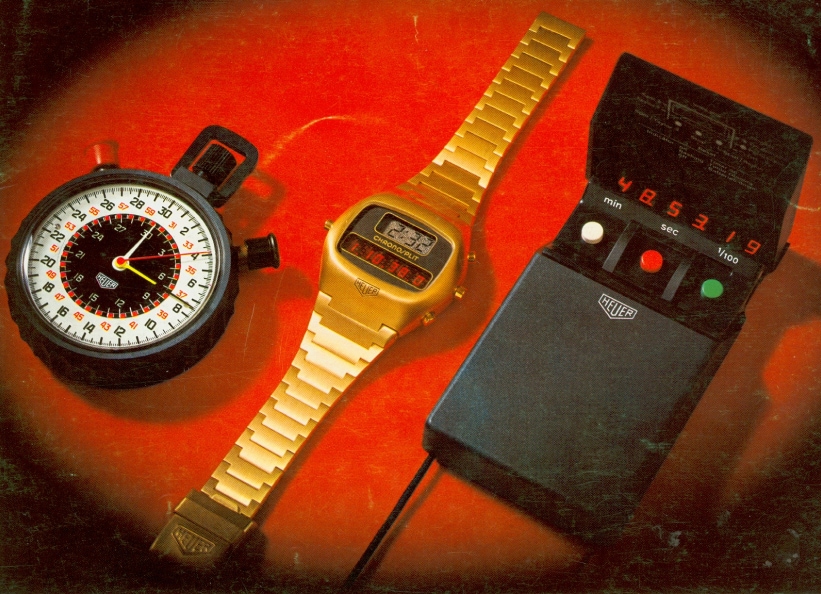
While today we may think of the digital watches as being less expensive than watches with mechanical movements, in the mid-to-late 1970s, Heuer’s electronic watches were positioned as the most expensive collections in the catalogue. Heuer’s 1978 catalog shows the Chronosplit priced at $425 and the gold-plated Manhattan priced at $550, above the prices of all the mechanical chronographs in the catalog (which were in the range from $250 to $375), with only one exception. The digital models were topped only by one watch -- the 18 karat gold Carrera, which was priced at $1,700.
In this article, we cover the first chronographs and watches that Heuer produced that were electronic (which some refer to as being “quartz” powered). We look at watches that had “digital” displays (which were either LCD or LED), as well as watches that used traditional hands to indicate the time-of-day.
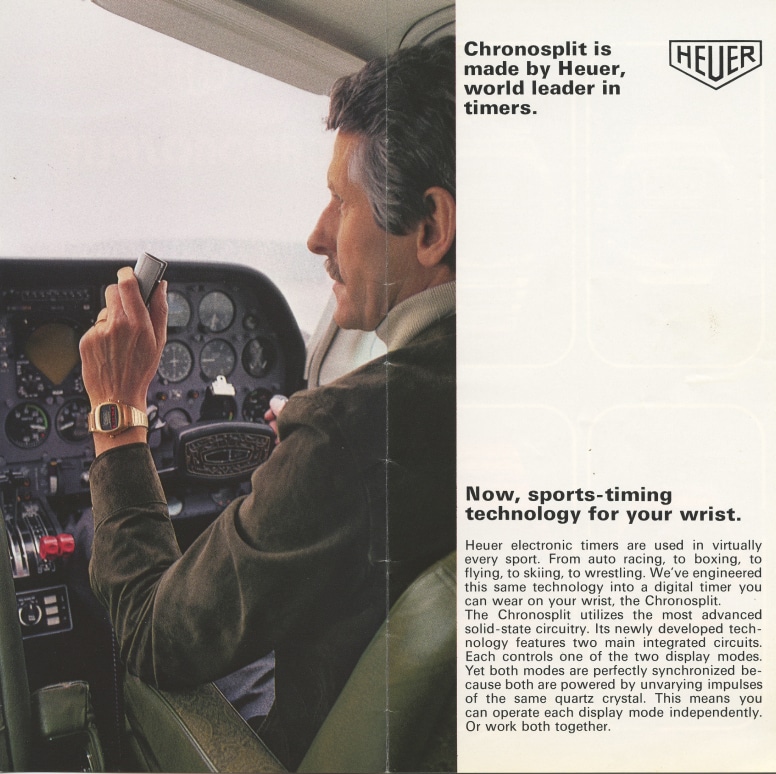
MOVEMENTS
Broadly speaking, there are two generations of movements used during this period: the Heuer developed movements in the mid-late 1970s and the ESA analogue/digital hybrid movement of the late 1970s and early 1980s.
The first generation of Heuer digital watches uses a series of movements developed by Heuer in conjunction with its partners in Silicon Valley, and is comprised of:
- Calibre 100: LCD/LED Chronograph
- Calibre 101: LCD, single display; time and date only
- Calibre 102: LCD/LCD Chronograph
- Calibre 103: LCD/LCD Chronograph (Ford Split Lap Unit 77)
- Calibre 104: LCD GMT (Manhattan)
- Calibre 105: LCD Chronograph
- Calibre 106: LCD Chronograph version of Calibre 101
- Calibre 107: LCD GMT (Senator)
The most technically innovative of the movements is the Calibre 100/102- the first solid-state digital wrist chronograph ever made. The Calibre is made up of two separate chips driven by a single 32kHz crystal on a common circuit board.
The chips were initially made by a company in the United States called Integrated Display Systems (IDS), with Heuer developing its own capability in 1977 when it created a specialist Microchip company called Heuer Micro-Technik SA (HMT).
What’s also obvious from looking at the Calibre 102 is the fragility of the movement, most notably the exposed thin wires connected to the two chips. Only one of these wires had to break for the watch to lose functionality, which explains why so few Chronosplits survive today, at least in their original form. This vulnerability was partly addressed on later movements, such as the Calibre 105, which provided better protection to the chips.
The rapid changes in technology and the economies of scale available in chip production meant that Heuer’s digital movements quickly became uncompetitive. The solution was to work with the ESA 900.231, a combined analogue/digital movement used by Heuer, Breitling and many other Swiss watch brands. ESA (Ebauches S.A) was the parent company of ETA, before a name change in the late 1970s saw all movements in the ESA group re-branded as ETA (for example, the Valjoux 7750 become the ETA 7750).
The design advances in the three years following the launch of the Calibre 100 are obvious, although these ESA movements are still fragile compared to the bullet-proof quartz movements of today.
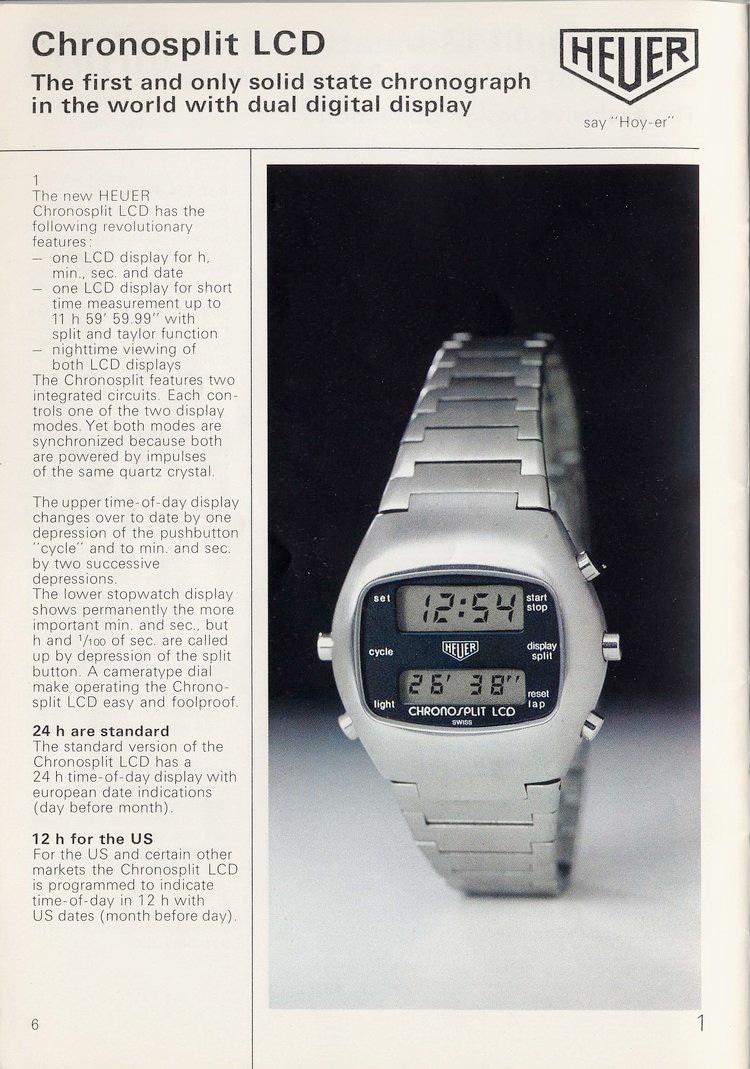
HEUER CHRONOSPLIT
The Heuer Chronosplit looked like it dropped down from space when it was launched at Basel Fair in 1975. The design was ultra-modern and a radical departure from the look of any other contemporary Heuer models. The Chronosplit is a genuine tool watch with a focus on delivering an ultra-precise chronograph function.
LCD/LED
The first execution of the Chronosplit had two digital displays, with the LCD (Liquid Crystal Display) display on top and the LED (Light Emitting Diode) display below. The reason that the Chronosplit has two windows is that early LCD technology could not move fast enough to display the 1/ 100th second accuracy demanded by the Chronosplit, something that LED could deliver. But LED was not practical enough to be used to display the time, as it absorbs too much power. The neat solution was to combine the two technologies: LCD for the time function and an LED chronograph, with its higher power consumption, that was only “live” when it was needed.
Heuer touted this first LCD/LED version of the Chronosplit as offering a precision timepiece that continually shows time-of-day, in big, bold black numerals, that allow instant reference, along with an incredibly accurate split-action stopwatch. The watch could be adjusted to maintain an accuracy of one minute per year, with the watch also being water resistant to a depth of 100 feet. The Chronosplit was offered with either an integrated metal bracelet (stainless steel or gold-plated) or a leather strap.
In addition to the standard model, there were two special editions of the LCD/LED Chronosplit, the most famous being the Ferrari-branded version, the second version is the watch made for Tiffany & Co. In addition to the stainless steel model, the Chronosplit was also available in a gold-plated model.
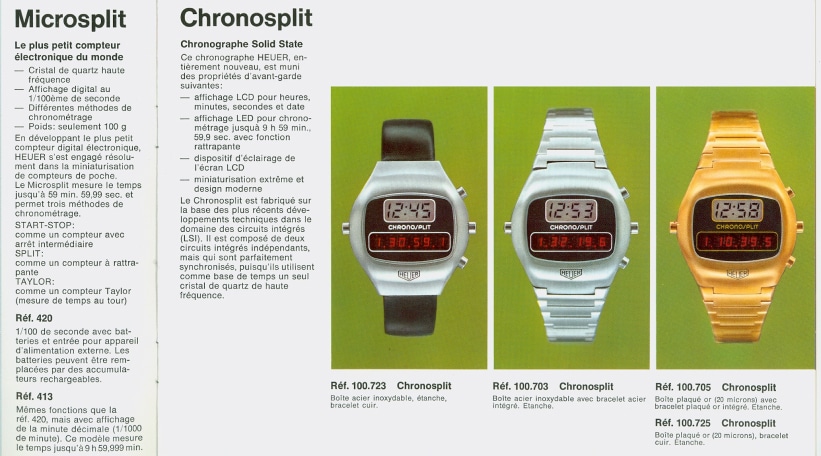
CHRONOSPLIT LCD
As LCD technology advanced, there was no longer a need for the LED component of the movement, meaning that second-generation Chronosplits changed to an LCD/LCD display in 1977. The other obvious change is the addition of menu labels on the screen to help remind owners exactly what each of the five buttons did.
The Chronosplit does not have “Swiss Made” on the dial, the case and bracelet were made in Switzerland, but the value of the movement that contained many parts from the United States meant that the watch was categorised as “Assembled in Switzerland”, indeed, some early LCD/LED Chronosplits were assembled in the United States.
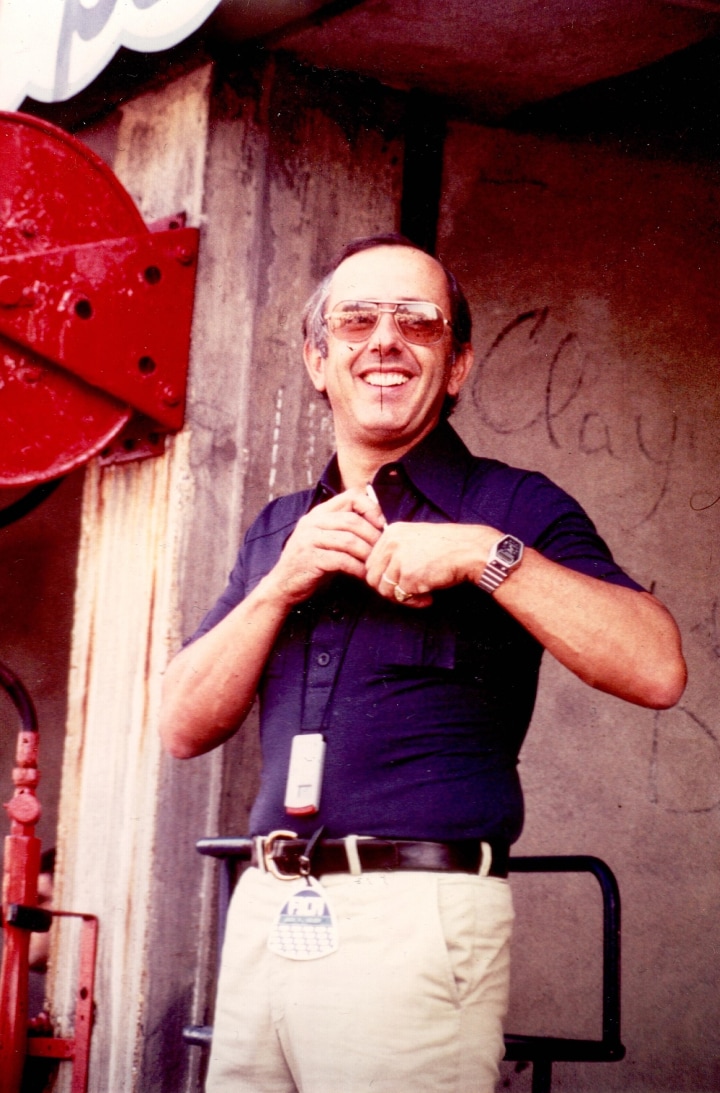
HEUER MANHATTAN
The Manhattan (actually the “Manhattan Chronosplit GMT”, as there is also a quartz-powered Manhattan watch, with traditional analogue hands) shares the dual dial layout of the Chronosplit, but replaces the digital time function with a traditional analogue clock (with hands to show the time of day). The case design of the Manhattan is just as bold as the Chronosplit, sporting a bullhead chronograph layout (pushers on top of the case) and locating the crown (used to set the hands) on the bottom fact of the six-sided case.
Stainless steel versions of the Manhattan Chronosplit GMT used either a black or a gray dial, while gold-plated cases incorporated either a black or a champagne dial.
While the design may have been bold, the movement powering the Manhattan may have been considered a step backwards from the Chronosplit models. The digital window is powered by the Heuer Calibre 104, while the analogue watch function uses a quartz Citizen movement. The two movements are in no way integrated, each using its own battery.
Manhattan “Quartz” watches had a single display, showing the time-of-day with traditional analog hands, with a date at 6 o’clock. Dials on the Manhattan Quartz watch were either gray or blue.
Like the Chronosplit, the Manhattan Chronosplit GMT is marked as “Assembled in Switzerland”, while the all-analogue Manhattan quartz watch carries “Swiss Made” on its dial.
The Manhattan was discontinued in 1982, the year that Heuer was sold to Piaget/Nouvelle Lemania. In 2005, the design of the Manhattan from the 1970s was brought back by fashion label DKNY (part of LVMH alongside TAG Heuer at the time). The name “DKNY” is marked in the center of the dial, between the digital display and the analog display.
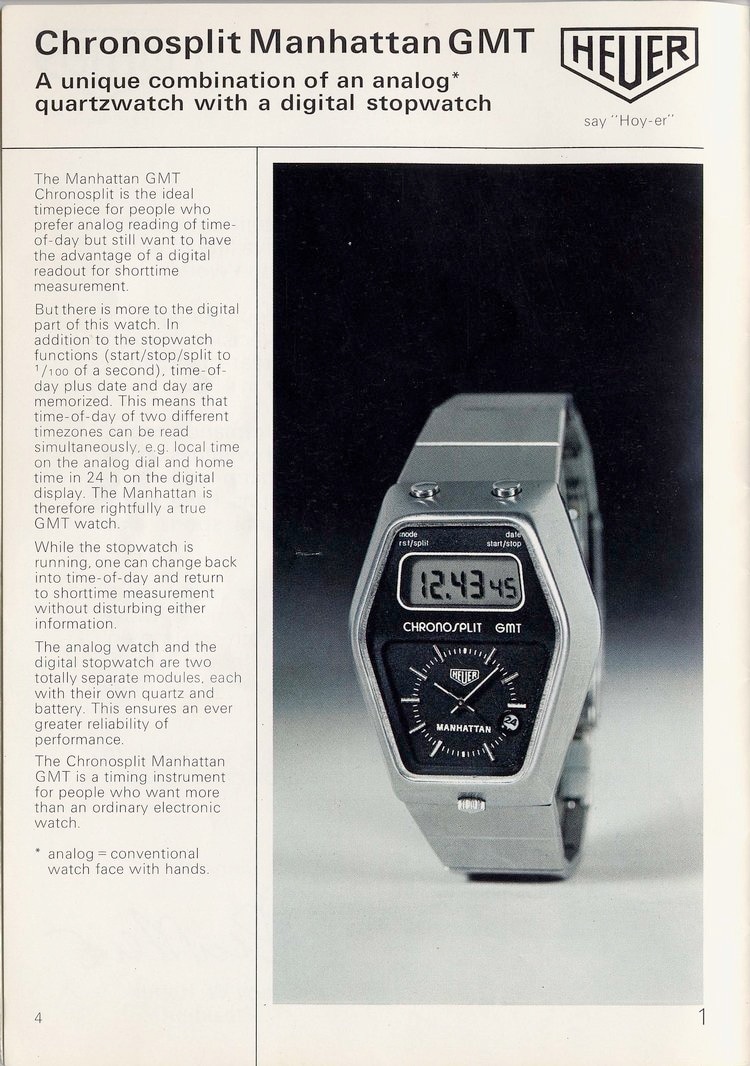
HEUER SENATOR
The Heuer Senator GMT was introduced in 1979 and has the same basic layout as the Manhattan, with the digital display above and the analog display (time of day hands) below. With the Senator, the hexagonal case of the Manhattan was replaced by a smooth lozenge-shaped case. The Senator was offered only as a dual-display chronograph, with no simple quartz watch being offered. Like the Manhattan, the Senator was part of the Heuer range until 1982.
Note that the Heuer Senator does proudly carry “Swiss Made” on the dial, it’s likely that the chips for the Calibre 107 in the Senator were sourced from Heuer Micro-Technik rather than from the United States, with IDS filing for bankruptcy in the late 1970s.
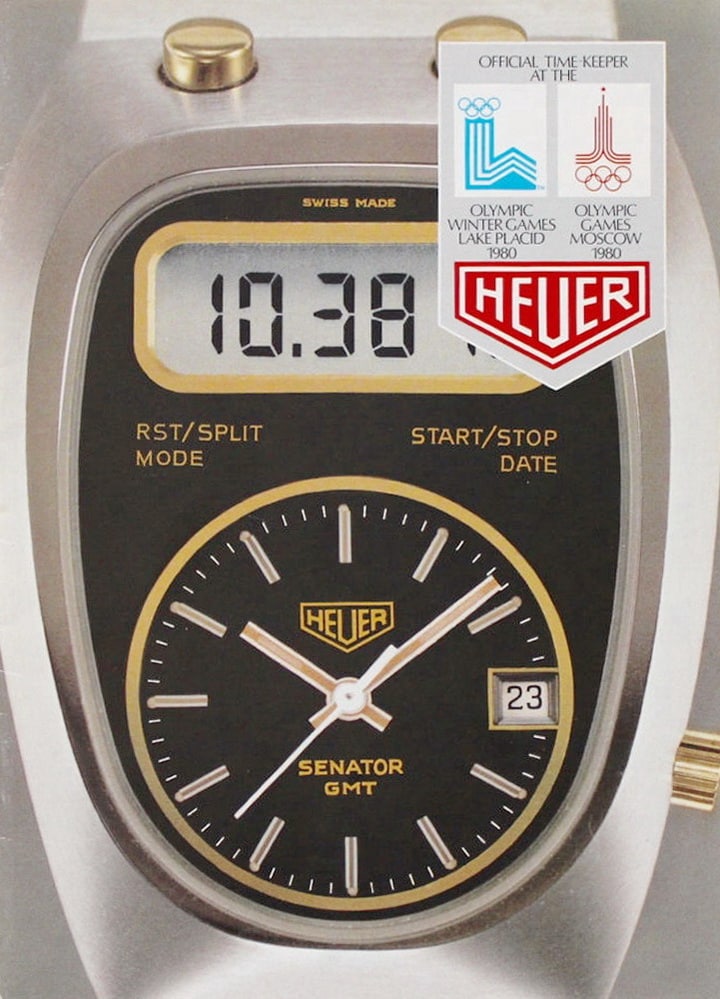
HEUER KENTUCKY
The Heuer Kentucky was launched in 1977 and was one of the first Heuer watches to use the Valjoux 7750 automatic movement. In addition to the mechanical versions of the Kentucky chronograph, there were several quartz models, including models with single and twin-screen LCD displays.
There are two versions of the LCD Kentucky models, the more common model being the single-screen watch, which uses the Heuer Calibre 105.
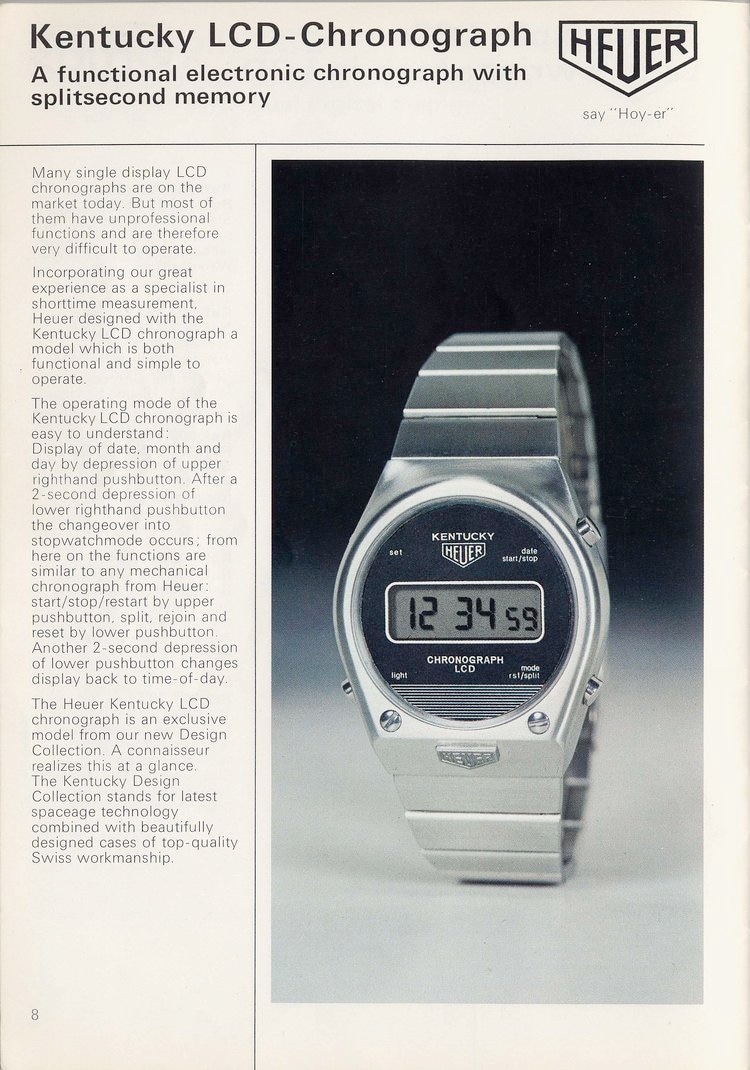
HEUER ESA DIGITALS
In 1978 Heuer launched a second-wave of digital models, this time powered by the ESA 900.231 movement. By 1978 the landscape for digital watches had totally changed. When the Chronosplit was launched in 1975 it sold for $450, a price that reflected its advanced technology and positioning as a luxury electronic watch. By 1978, digital watches with the same functionality were available for a small fraction of the price.
Heuer’s bespoke low-volume movements were simply too expensive to be further developed and so digital movements were now sourced from ESA, which took the same approach as the Manhattan and Senator in combining an analogue watch with a digital chronograph and other functions.
CARRERA
The electronic Carrera took a more conservative approach than the earlier Heuer digitals, looking far more like a “normal” watch than the earlier Heuer digitals pieces. In fact, the C-shaped case of this Carrera follows the same basic contours as the case that Heuer introduced for the first automatic (Calibre 12) Carrera in 1969 and was sold for the same price as the automatic version.
VERONA
Also available as an electronic model was the Heuer Verona, a niche dress-watch series launched in 1978 initially with an automatic Calibre 12 movement. While the Carrera was more of a sports watch, the Verona had an elegant, refined design.
HEUER 1000
In the late 1970s, Heuer began to roll out a full range of dive watches, with the first collection being the 1000 Series. The Heuer 1000 was the last of the Heuer digital watches, being launched in 1982. By the time the 1000 was launched, it was the only Heuer digital watch available, with the previous models having been discontinued
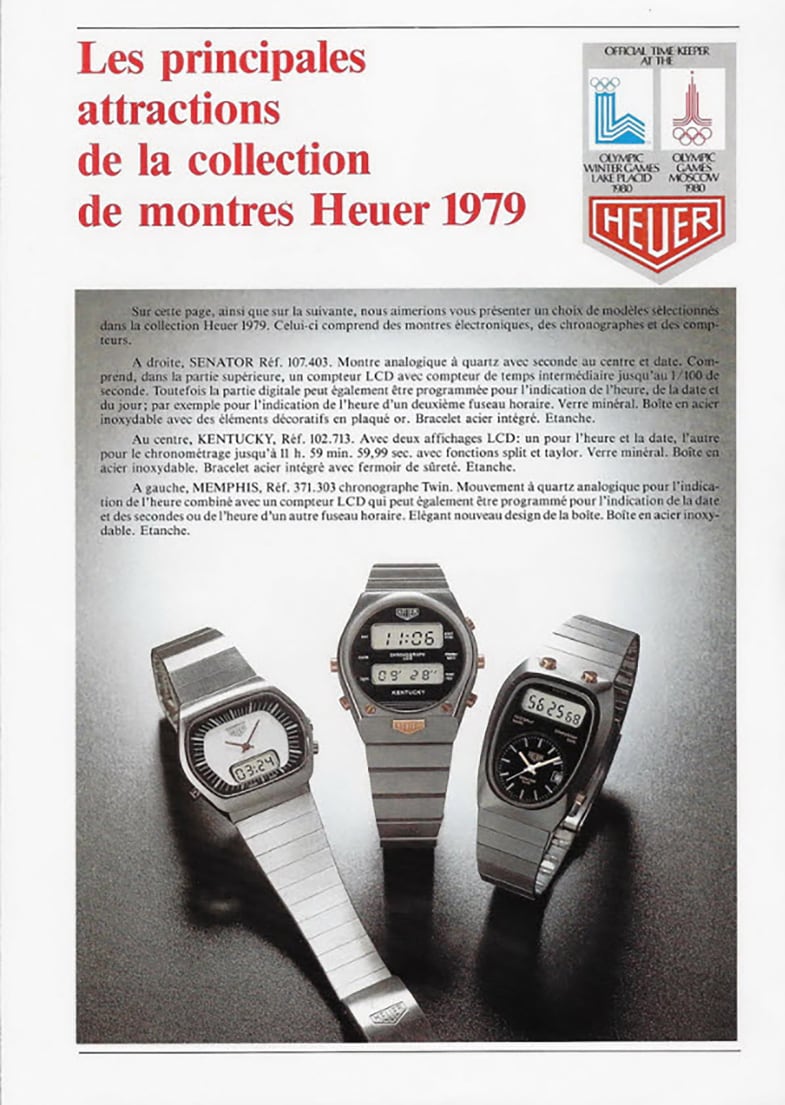
RARE HEUER DIGITALS
FORD RS SPLIT LAP 77
Introduced in 1977, the Ford Split Lap Unit 77 chronograph was designed by Ford Rallye Sport (RS) (Germany) and manufactured by Heuer. The watch did not carry any Heuer logos and was powered by the Calibre 103 movement. The two discs at the bottom of the top surface of the watch house the batteries.
HEUER MEMPHIS
In 1979 Heuer introduced the Memphis collection of watches, consisting of a digital chronograph with analog hands showing the time of day, as well as a digital display and a simpler quartz watch, with analog hands. Both these models were shown with either gray or black dials, but it appears that the model never went into full production (with the death of Elvis Presley in 1977 perhaps detracting from the appeal of the watch).
REF 16061
Introduced in 1979, the reference 16061 used a single LCD display, in a more traditional rectangular case. By pushing the button, the watch would display the day, date and month.
